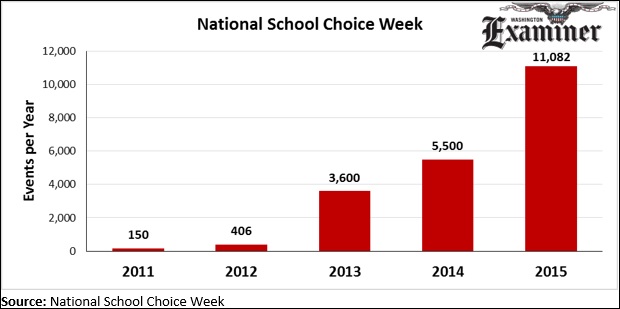By the end of the week, over 11,000 events across the country will have celebrated National School Choice Week, just four years after the annual celebration began.
The movement has shown incredible growth, beginning with just 150 events in 2011 and more than doubling in size every year. Although the celebrations all fall under the same banner of National School Choice Week, they are independently funded and planned, making the grassroots growth of the movement even more impressive.
“More and more schools … want to participate in National School Choice Week because of our positive focus,” Andrew Campanella, the President of National School Choice Week, told the Washington Examiner. “We’re seeing, across the country, significantly more excitement and energy around the issue of school choice. Parents want to be able to personalize and customize the education that is provided to their children.”
The school choice movement has plenty to celebrate. On top of the many school choice programs already in place, several new ones launched in the past year.
For example, North Carolina now grants vouchers to low-income public school students through its Opportunity Scholarships program. Up to 35 percent of North Carolina families live off incomes low enough to qualify for the program, which will allow them to use a voucher for tuition, transportation or equipment required by a participating private school. In Arizona, the Empowerment Scholarship Accounts program was so successful that eligibility expanded. Now, 20 percent of Arizona’s K-12 students are eligible for the program, according to the Friedman Foundation for Educational Choice.
“This year, more American families are actively choosing schools for their kids than ever before in history,” Campanella said. That means fewer kids in failing schools, and more students receiving an effective education.
Fortunately, the school choice movement enjoys bipartisan support. One of the National School Choice Week partners is Democrats for Education Reform. Among other things, the group says it stands for “mechanisms that allow parents to select excellent schools for their children, and where education dollars follow each child to their school.”
Additionally, Gov. Jack Markell, a Democrat from Delaware, issued a proclamation recognizing National School Choice Week, in addition to 64 Democratic mayors. “When you look at the mayor count, we’re seeing actually a higher number of Democrats than Republicans in these bigger cities, which is remarkable,” Campanella said.
Despite the bipartisan nature of the school choice movement, some detractors remain. The School Superintendents Association published a piece on its blog about pushing back against National School Choice Week. “In unity with and as co-chair of the National Coalition for Public Education, a coalition of over 50 national education, civil rights, religious and secular organizations, AASA joins with these groups to oppose and inform the public of the real focus of this event — the push for private school vouchers,” the blog read.
But school choice isn’t just about vouchers. “We as an effort shine a spotlight on all different types of school choice, whether its open-enrollment in traditional public schools, or public charter schools, magnet schools, online learning, homeschooling, etc., and private school choice,” Campanella said.
What began as a small group of dedicated individuals has now become a mainstream, bipartisan movement in support of the right for a student to choose a better education.

